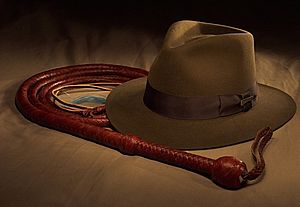Kangaroo leather facts for kids
Kangaroo leather is a special type of leather that comes from the skin of kangaroos. It's known for being very strong but also super light!
Kangaroos are part of an industry where they are carefully managed. Both their meat and their hides (skins) are used. Most types of kangaroos are protected by law. However, some larger kangaroo species, which have very big populations, can be hunted by special commercial hunters. This is done under strict rules. Some people who care about wildlife don't agree with this practice.
Contents
What Kangaroo Leather Is Used For
Kangaroo leather is used for many different things. It's very popular for making all kinds of shoes. This is because its special structure allows it to be cut very thin. Even when it's thin, it stays super strong.
You can also find kangaroo leather in motorbike gear for riders. It's used in car seats, military boots, and even football or soccer boots. Plus, it's a great material for fashion items like bags and wallets.
Whip makers love kangaroo leather too. They can cut it into thin strips. This makes whips flexible but still very tough and long-lasting.
Why Kangaroo Leather Is So Strong
Scientists have studied kangaroo leather. The Australian Commonwealth Scientific and Industrial Research Organisation (CSIRO) found that it's one of the strongest leathers you can find. This is true even when compared to other leathers of the same thickness.
When kangaroo leather is made thinner, it keeps a lot of its original strength. For example, if you make it 20% of its first thickness, it still has 30% to 60% of its strength. But if you do the same with calf leather, it only keeps 1% to 4% of its strength.
Kangaroo leather is also lighter and stronger than leather from cows or goats. It's about 10 times stronger than cowhide. It's also 50% stronger than goatskin.
How Kangaroo Skin Is Different
The secret to kangaroo leather's strength is in its structure. In cow skin, the tiny fibers are woven in a complex way. They can be at sharp angles to the skin's surface. Cow skin also has sweat glands and muscles that make hair stand up.
Kangaroo skin is different. Its fibers are mostly arranged in a neat, parallel way, flat against the skin. It doesn't have sweat glands or those hair-raising muscles. The stretchy parts (elastin) are spread evenly. This uniform structure makes the leather very strong. It also helps it stay strong even when it's made thinner. Cow skin has more weak spots where tears can start. When cow skin is sliced, many fibers get cut, which also makes it weaker.
Kangaroo Leather and the Environment
The kangaroo industry in Australia is carefully managed by the government. They make sure that kangaroos are harvested in a way that is sustainable and humane. This means they only take a certain number of animals.
Many Australian scientists who study the environment support the kangaroo industry. They believe it's good for the environment and sustainable. They argue that kangaroos are native to Australia. This makes them a better choice for livestock than sheep and cattle, which were brought from other countries.
Kangaroos are better for Australia's dry climate for a few reasons:
- They need less water to breathe than cows or sheep. Kangaroos use their leg muscles to help them breathe efficiently when they hop.
- Their soft paws don't compact the ground like the hooves of cattle and sheep. Instead, their hopping can create small, bowl-shaped marks in the soil. These marks help catch water and seeds, which can help native grasses grow.
Because of these reasons, kangaroos use less water from the ground. They could even survive without special water sources like bore water. Many people think that kangaroos could be a more environmentally friendly option for farming in dry areas than sheep and cattle. Kangaroos are also eaten in most parts of Australia.


